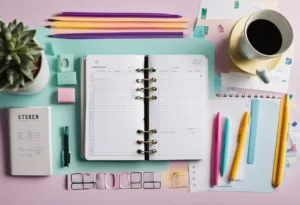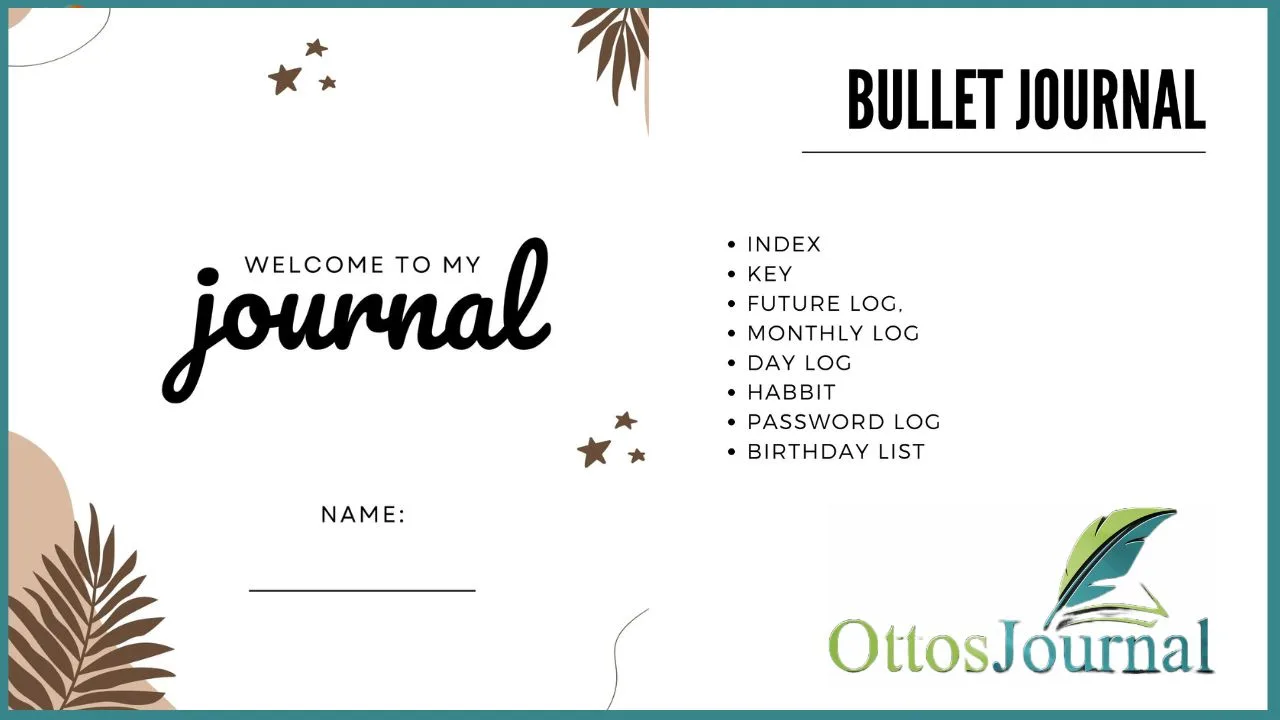Bullet journaling has become a popular system for organizing tasks, goals, and daily life. It is a flexible method that allows individuals to customize their journal to their needs. However, some people may find it challenging to maintain a separate journal for bullet journaling. This is where bullet journaling in a planner comes in handy. In this article, I will share with you how to start bullet journaling in a planner.
Combining bullet journaling with a planner can provide an efficient and organized system for keeping track of tasks, appointments, and goals. It allows individuals to have all their daily needs in one place, making it easy to access and manage. Bullet journaling in a planner also provides a creative outlet for those who enjoy adding their personal touch to their organization system.
We will discuss the different ways to incorporate bullet journaling into a planner, including using pre-made planner templates or creating custom layouts. I will also provide tips and tricks for maximizing the effectiveness of a bullet journal planner system.
What is the Bullet Journal Planning Method?
The Bullet Journal Planning Method is a system of organizing tasks, events, and thoughts in a simple and efficient way. It was created by Ryder Carroll, a New York-based designer, and it is a mix of a daily planner, to-do list, and diary.
The system works by letting you capture and organize tasks, events, and thoughts efficiently in a process known as rapid logging. Rapid logging is the heart of the Bullet Journal method. It functions by using short, bulleted entries to indicate what something in your list is and at what stage of completion it’s at.
The Bullet Journal method helps you organize your thoughts and tasks and intentionally plan your schedule. In your bullet journal, you can log tasks, events, and notes in short-form sentences — aka “bullets.” This system is designed to help you track the past, organize the present, and plan for the future.
To use the Bullet Journal Planning Method, you’ll need a notebook, a pen, and a few minutes each day to plan out your tasks and events. You can customize your journal to your intentions and needs, and the system is flexible enough to work for anyone, no matter their lifestyle or work habits.
How to Use a Planner and Bullet Journal?
Bullet journaling is a great way to keep track of your tasks, events, and thoughts. However, not everyone wants to start from scratch with a blank notebook. Fortunately, you can use a planner as a bullet journal with a little bit of creativity. Here are three ways to use your planner as a bullet journal:
- Create a Key Page: The key page is an essential part of the bullet journal system. It helps you keep track of symbols and colors you use to categorize your tasks. You can create a key page in your planner by using a blank page or a sticky note. Write down the symbols you want to use, such as a dot for tasks, a triangle for events, and a dash for notes. Then, assign colors to each symbol to make them stand out.
- Use the Monthly Spread: Most planners come with a monthly spread that shows a calendar for the current month. You can use this spread as a monthly log in your bullet journal. Write down important events and tasks for the month and add symbols to categorize them. You can also add a habit tracker to the monthly spread to keep track of your daily routines.
- Create a Collections Section: Collections are pages in a bullet journal that are dedicated to specific topics, such as books to read, movies to watch, or project ideas. You can create a collections section in your planner by using sticky notes or tabs to mark the pages. Write down the title of the collection and add items to the list as you go. You can also use symbols and colors to categorize the items and mark them as completed.
By using these three techniques, you can turn your planner into a functional bullet journal that helps you stay organized and focused on your goals. Experiment with different layouts and designs to find the ones that work best for you.
How to Start Bullet Journaling in a Planner
Bullet journaling in a planner can be an effective way to stay organized and focused. Here are some tips for getting started:
Choosing the Right Planner and Supplies
When choosing a planner for bullet journaling, it is essential to select one that meets your needs. Consider the size, layout, and the number of pages. A pen, notebook, and markers are all you need to start bullet journaling.
Understanding the Bullet Journal System
The bullet journal system was invented by Ryder Carroll in 2013. It is a simple and flexible system that can be customized to suit individual needs. The system involves using a key, index, future log, monthly log, and daily log. These elements help users keep track of tasks, goals, and notes.
Setting Up Your First Bullet Journal
To set up your first bullet journal, begin by creating an index and key. Then, create a future log, monthly log, and daily log. Add any additional collections, such as habit trackers or goal pages. Keep the layout simple and easy to use.
Customization and Personalization
Bullet journaling is highly customizable and personal. Users can add color coding, stickers, and doodles to make their journal unique. Experiment with different layouts and techniques to find what works best for you.
Bullet Journal Techniques for Beginners
As a beginner, start with simple techniques such as creating a to-do list, calendar, and daily pages. Incorporate habit trackers to monitor progress and set achievable goals. Use symbols and signifiers to keep track of tasks and priorities.
Bullet Journal for Productivity and Time Management
Bullet journaling can be an effective tool for productivity and time management. Use it to prioritize tasks, set deadlines, and create a work-life balance. Consistency is key to achieving success with bullet journaling.
Bullet journaling in a planner can be an effective way to stay organized and focused. By choosing the right planner and supplies, understanding the bullet journal system, setting up your first bullet journal, customizing and personalizing it, using beginner techniques, and using it for productivity and time management, users can achieve their goals and stay on track.

Bullet Journal Planner Ideas
Bullet journaling in a planner can be a great way to stay organized and keep track of your tasks. Here are five bullet journal planner ideas to help you get started:
- Monthly Spread: Create a monthly spread in your planner to keep track of important events, appointments, and deadlines. Use colorful pens or markers to make it visually appealing.
- Habit Tracker: Use a habit tracker to help you establish and track new habits. This can be a great way to stay motivated and keep yourself accountable.
- Meal Planner: Use your planner to plan out your meals for the week. This can help you save time and money, and ensure that you’re eating healthy and balanced meals.
- Gratitude Log: Create a gratitude log in your planner to help you focus on the positive things in your life. This can be a great way to reduce stress and increase happiness.
- Brain Dump: Use your planner as a place to do a brain dump. Write down all the things that are on your mind, and then organize them into actionable tasks. This can help you feel more in control and reduce overwhelm.
By implementing these bullet journal planner ideas, you can increase your productivity and stay organized.
Bullet Journal Ideal Schedule
Bullet journaling in a planner is an excellent way to organize your life and stay on top of your goals. However, it requires a bit of planning to ensure that you get the most out of your bullet journaling experience. Here are some tips for creating an ideal bullet journal schedule:
Create a Daily To-Do List
The first step to creating an ideal bullet journal schedule is to create a daily to-do list. This list should include all of the tasks that you need to complete for the day, including work-related tasks, personal tasks, and any other tasks that you need to complete. Having a to-do list will help you stay focused and ensure that you don’t forget anything important.
Use a Weekly Spread
In addition to creating a daily to-do list, it’s also important to use a weekly spread in your bullet journal. A weekly spread is a great way to see all of your tasks and appointments for the week at a glance. You can use a weekly spread to plan out your week and ensure that you have enough time to complete all of your tasks.
Track Your Habits
Tracking your habits is another important aspect of bullet journaling in a planner. You can use your bullet journal to track your daily habits, such as exercise, meditation, or reading. Tracking your habits will help you stay on track and ensure that you’re making progress towards your goals.
Set Goals and Deadlines
Finally, it’s important to set goals and deadlines in your bullet journal. Setting goals will help you stay motivated and focused, while deadlines will ensure that you complete your tasks on time. You can use your bullet journal to set both short-term and long-term goals, and to track your progress towards achieving those goals.
Creating an ideal bullet journal schedule requires a bit of planning and organization. By creating a daily to-do list, using a weekly spread, tracking your habits, and setting goals and deadlines, you can stay on top of your life and achieve your goals with ease.

Bullet Planner Examples
Bullet journaling in a planner can be a great way to stay organized and productive. Here are three examples of how to use a bullet journal in a planner:
Example 1: Daily Tasks
One way to use a bullet journal in a planner is to create a daily task list. This can be done by creating a small section on each day of the planner where tasks can be written down. Using a bullet system, tasks can be marked as complete, incomplete, or postponed. This can help keep track of what needs to be done each day and can also help prioritize tasks.
Example 2: Monthly Goals
Another way to use a bullet journal in a planner is to create a monthly goals section. This can be done by creating a separate page for each month where goals can be written down. Using a bullet system, goals can be marked as achieved, in progress, or postponed. This can help keep track of progress towards goals and can also help with motivation.
Example 3: Habit Tracker
A third way to use a bullet journal in a planner is to create a habit tracker. This can be done by creating a grid on a separate page where habits can be tracked daily. Using a bullet system, habits can be marked as completed or not completed each day.
This can help with forming new habits and can also help with accountability. By using these examples, bullet journaling in a planner can be a useful tool to stay organized and productive.
Advanced Bullet Journaling
Creative Layouts and Collection Ideas
Bullet journaling is an artistic and creative system that enables users to express themselves while staying organized. Advanced bullet journaling involves experimenting with creative layouts and collection ideas. Users can create custom layouts that suit their needs and preferences, such as weekly, monthly, or yearly layouts.
They can create collections for various purposes such as a gratitude log, meal plan, or habit tracker. These collections can help users track their progress and stay motivated.
Incorporating Habit and Fitness Trackers
Bullet journaling is an effective way to track habits and fitness goals. Advanced bullet journaling involves incorporating habit and fitness trackers into the system. Users can create trackers to monitor their progress towards their health and fitness goals. They can also use habit trackers to establish new routines and track their progress towards achieving their goals.
Reflective Practices and Long-Term Planning
Reflective practices and long-term planning are essential components of advanced bullet journaling. Users can use their bullet journals to reflect on their progress and plan for the future. They can create future logs to plan their goals for the month or year ahead. Users can use their bullet journals to review their progress and adjust their plans as necessary.
Bullet Journaling for Work and Personal Life
Bullet journaling can be used to manage both work and personal life. Advanced bullet journaling involves creating a structure that works for both aspects of life. Users can create collections for appointments, events, and meal planning. They can also create routines that allow them to balance their work and personal life effectively.
Optimizing Your Bullet Journaling System
Optimizing your bullet journaling system involves finding the right balance between structure and flexibility. Users can experiment with different layouts and collections to find what works best for them. They can create routines that allow them to adapt to changes in their life while staying organized and productive.

Frequently Asked Questions
What are the benefits of combining a bullet journal with a traditional planner?
Combining a bullet journal with a traditional planner can offer the best of both worlds. A traditional planner provides structure and organization while a bullet journal offers flexibility and customization. By combining the two, you can create a system that works best for your needs. You can use pre-structured pages to plan your day, week, or month and use bullet journaling for habit tracking, goal setting, and creative expression.
How can one adapt the bullet journal method for use in a pre-structured planner?
To adapt the bullet journal method for use in a pre-structured planner, you can use the key elements of bullet journaling such as rapid logging, migration, and collections. You can use symbols to mark tasks, events, and notes in your planner, and migrate unfinished tasks to the next day or week. You can also create collections for specific projects or goals and use the index to keep track of them.
What are some creative bullet journal layouts that can be incorporated into a planner?
Some creative bullet journal layouts that can be incorporated into a planner include mood trackers, habit trackers, gratitude logs, and meal planners. You can also create collections for books to read, movies to watch, or places to visit. The possibilities are endless, and you can customize your planner to reflect your interests and goals.
What are the key differences between a bullet journal and a standard planner?
The key differences between a bullet journal and a standard planner are flexibility and customization. A standard planner has pre-structured pages with limited space for notes and creativity, while a bullet journal allows you to create your own pages and layouts. You can also use symbols, colors, and drawings to express yourself and make your planner unique.
How can a bullet journal approach enhance productivity and organization in a work setting?
A bullet journal approach can enhance productivity and organization in a work setting by providing a system for task management, goal setting, and time tracking. By using symbols and rapid logging, you can quickly capture and organize your tasks and ideas. Creating collections for projects and goals can stay focused and motivated.
A habit tracker can develop good habits and improve your productivity.
What essential elements should be included in a bullet journal spread within a planner?
The essential elements of a bullet journal spread within a planner include the index, key, future log, monthly log, weekly log, and daily log. The index helps you find your collections and pages quickly, while the key explains the symbols you use.
The future log helps you plan ahead for the year, while the monthly log and weekly log help you plan for the month and week. The daily log helps you plan your day and track your tasks and events.




